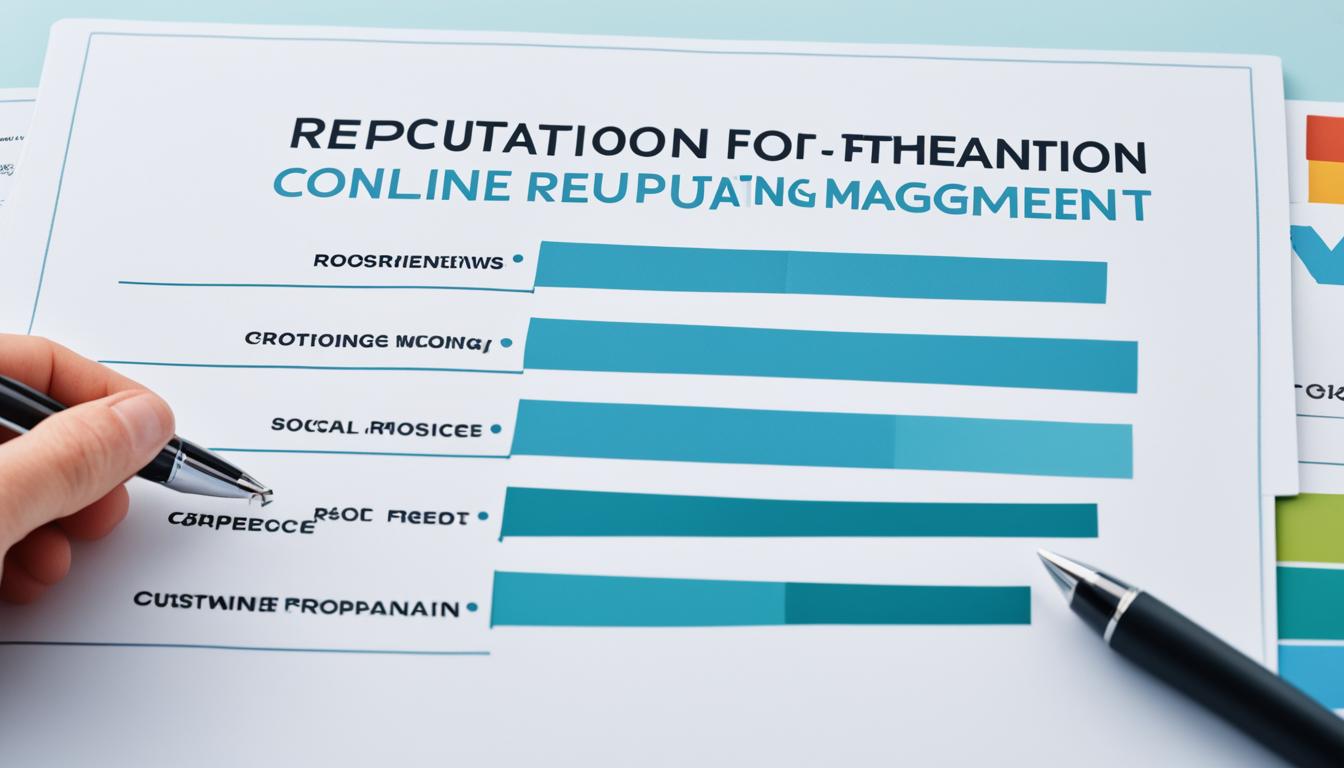Ever thought how one online review can change a business’s fate? In today’s digital world, your online reputation is priceless. With 88% of consumers checking reviews before buying1, managing your digital image is vital.
Your online presence mirrors your brand’s values and trustworthiness. It’s not just about what you say. What others say about you online matters too. Every digital spot, from social media to review sites, shapes your reputation.
Creating and keeping a good online reputation takes a lot of effort. It includes content marketing, social media, handling customer reviews, and being proactive. These elements help build a strong digital image that stands up to scrutiny and gains trust with your audience.
In today’s digital era, we can’t overlook our online reputation. It’s a constant effort that needs strategy and consistency. By mastering online reputation management, we can shape how people see our brand online.
Key Takeaways
- Online reviews heavily influence consumer decisions
- Digital presence reflects brand values and credibility
- Multiple elements contribute to online reputation
- Proactive management is crucial for a positive image
- Consistency is key in maintaining digital reputation
Understanding Online Reputation Management
Online Reputation Management (ORM) is key for businesses today. It’s about keeping an eye on and shaping how people see your brand online. A good ORM strategy builds trust, loyalty, and helps with buying decisions. In fact, 60% of U.S. consumers won’t buy from brands they don’t trust2.
ORM covers many parts of a company’s online presence. This includes content marketing, managing social media, and handling customer reviews. Social listening and online monitoring are also important. They keep businesses in the loop about what people say about them.
ORM has a big impact on business success. For example, 75% of customers might spend more with a business they follow on social media3. Also, 97% of consumers check out product reviews before buying2. These facts show how crucial it is to keep a good brand image online.
Social media plays a big part in ORM. A study found that 43% of consumers use social networks to learn about brands, products, or services4. It’s important to quickly answer customer questions on these platforms. In fact, 69% of consumers expect a fast reply when they talk about a brand on social media or leave a review4.
To have a strong ORM strategy, there are steps to follow. First, do an online reputation audit. Then, set priorities and create guidelines for communication. This way, businesses can manage their online presence better and build strong relationships with customers.
Content Marketing as a Reputation Builder
Content marketing is key to shaping a brand’s online image. It’s clear that 76% of consumers trust a brand more when it shares quality content5. This shows how important a strong content plan is for building a brand’s identity.
Sharing valuable content helps build trust. In fact, 83% of marketers think sharing insightful content is key for trust5. This way, brands can show off their knowledge and connect with their audience.

Being a thought leader in content creation is powerful. By sharing informative blog posts, we can be seen as experts in our field. 72% of marketers see blog content as vital for being seen as authorities5.
Customer testimonials are great for credibility. 58% of B2B marketers think they’re the most powerful type of content5. Plus, 82% of consumers feel more confident buying after reading good reviews5.
Choosing topics that match what customers care about is key. This approach can really get people engaged6. Remember, being relevant, consistent, and high-quality are the keys to a great content strategy6.
Now, video content is getting more popular. 69% of consumers like watching short, informative videos to learn about products or services5. This shows we need to use different types of content in our marketing.
By focusing on these points, we can make a strong content marketing plan. This plan will not just build but also keep a positive online image.
The Role of Social Media in Shaping Perception
Social networks are huge in shaping how we see brands. With billions of users, they have a big impact on what we think7. A single bad event can spread fast, hurting a company’s image.

Being active on social media is key to a good brand image. 51% of people think brands that talk back to customers on these platforms stand out8. This shows how important it is to communicate well and quickly to build support.
Tools like Brandwatch and Hootsuite give deep insights into what people are saying7. They help brands see what’s being talked about and what might be a problem. By using these tools, companies can handle issues fast and keep a good online image.
Social media really changes how we see brands. 68% of people follow brands to learn about new stuff8. This is a chance for businesses to show off what they know and get noticed. But, it’s important to keep a consistent image everywhere to really connect with people9.
Influencer marketing is a strong way to shape how people see a brand. Bloggers and online stars on YouTube and Instagram really influence what we think9. Working with these influencers lets brands reach more people and gain trust with their audience.
In the end, social media is key to managing a brand’s online reputation. By talking to customers, using social listening tools, and working with influencers, brands can shape their online image and get people to see them in a good light.
Customer Reviews and Their Impact
Customer reviews shape online reputations and influence buying decisions. A staggering 85% of consumers research online before purchasing, trusting reviews as much as personal recommendations1011. This trust translates into real business impact, with a single star difference in ratings potentially affecting revenues by 5-9%10.

Effective review management yields remarkable results. One study found a 500% increase in positive reviews and a 60% decrease in negative ones through managed services10. This improvement in star ratings can lead to significant sales growth, highlighting the importance of proactive review strategies.
Review sites serve as powerful platforms for customer feedback. They not only influence potential buyers but also impact search engine rankings. Businesses with high ratings and positive reviews are more likely to appear in local search results, potentially increasing organic traffic by 28.55%11.
To maximize the benefits of customer testimonials:
- Encourage satisfied customers to leave feedback
- Respond professionally to all reviews, especially negative ones
- Use feedback to improve products and services
- Monitor review sites regularly
By focusing on these aspects, businesses can harness the power of customer reviews to build a strong online reputation and drive growth.
Key Elements of Online Reputation
Building a strong online reputation takes a lot of effort. We’ve found several key elements that are essential for a strong digital presence. These elements work together to shape how people see your brand online.

Content marketing is key to building a good reputation. By making valuable content, brands can show they’re leaders in their field. This approach draws in potential customers and helps in handling crises.
Social media is very important for how people see your brand. A huge 71% of customers are more likely to recommend a brand if they have a good social media experience12. So, having active and engaging social profiles is a must for your marketing.
Customer reviews have a big impact on a brand’s reputation. With 90% of people reading reviews before visiting a business, managing your reviews is crucial12. Good reviews make 74% of people trust a business more, while bad reviews can scare off 60% of potential customers13.
| Reputation Element | Impact | Action Required |
|---|---|---|
| Content Marketing | Establishes industry leadership | Create valuable, informative content |
| Social Media Presence | Shapes public perception | Maintain active, engaging profiles |
| Customer Reviews | Influences consumer trust | Encourage and manage reviews |
| Brand Advocacy | Amplifies positive reputation | Cultivate relationships with satisfied customers |
| Employee Satisfaction | Affects employer brand | Prioritize internal culture and employee experience |
Answering to reviews can boost customer loyalty by up to 70%, showing how important it is to engage with customers12. This approach helps deal with reputation issues and shows you care about customer satisfaction.
Happy employees are key too. With 84% of job seekers looking at a company’s reputation as an employer, having a positive work culture is crucial for getting great talent13. A good work culture can greatly improve your brand’s image.
Conclusion: Nurturing a Positive Online Presence
Online reputation building is key in today’s digital world. A huge 97% of consumers check out reviews online before buying something, and 88% trust these reviews as much as advice from friends14. This shows how big of an impact our online actions have on trust and managing our brand.
Our online image is often the first thing new customers see. Studies reveal that 93% of buying choices are swayed by what they read online15. This proves we need a strong plan for managing our reputation. By connecting with customers on social media, we can increase loyalty and spending by 20-40%15.
Also, 86% of consumers are hesitant to buy from a business with bad online reviews14. To fight this, we should answer at least 75% of customer complaints on social platforms. This can greatly increase customer support15. By keeping a positive online image through consistent value and good customer service, we build trust, loyalty, and grow our business.
FAQ
What is online reputation management (ORM)?
Why is content marketing important for online reputation?
How does social media impact a brand’s online reputation?
Why are customer reviews important for online reputation?
What are the key elements of online reputation?
How can a business nurture a positive online presence?
Source Links
- Online Reputation: The Guide to Managing Your Digital Presence – https://www.eskimoz.co.uk/online-reputation/
- A Beginner’s Guide to Online Reputation Management – https://www.semrush.com/blog/online-reputation-management/
- 7 Essential Elements of Online Reputation Management – https://konnectinsights.com/blogs/elements-of-online-reputation-management/
- Everything you need to know about online reputation management – https://sproutsocial.com/insights/online-reputation-management/
- Why Content Credibility Is So Important for Online Reputation – https://rizereviews.com/why-content-credibility-is-so-important-for-building-a-trustworthy-online-reputation/
- Reputation Management: Here’s How Content Marketing Can Help – https://storychief.io/blog/reputation-management-content-marketing
- The Role of Social Media in Reputation Management | Consultus Digital – https://consultusdigital.com/blog/role-of-social-media-reputation-management/
- Social media reputation management: How to stay in good standing with your audience – https://sproutsocial.com/insights/social-media-reputation-management/
- Ways Of Using Social Media For Online Reputation Management – https://konnectinsights.com/blogs/ways-of-using-social-media-for-online-reputation-management/
- The Impact of Online Reputation Management – Reputation – https://reputation.com/resources/reports-research/case-study-impact-of-online-review-management/
- Customer Reviews: Key Point in Online Reputation Management – https://digitaldelane.com/the-importance-of-customer-reviews-in-online-reputation-management
- 5 Key Elements Of Online Reputation Management – https://reputationdefender.medium.com/5-key-elements-of-online-reputation-management-4111401aa201
- Online Reputation Management: How to Protect Your Brand | InMoment – https://inmoment.com/blog/online-reputation-management/
- The Impact of Online Reputation on Consumer Perception and Purchase Behavior – https://www.linkedin.com/pulse/impact-online-reputation-consumer-perception-purchase-devin-miller-3m1nc
- Power Of Online Reputation Management In Digital Marketing – https://growth99.com/power-of-online-reputation-management-in-digital-marketing/

